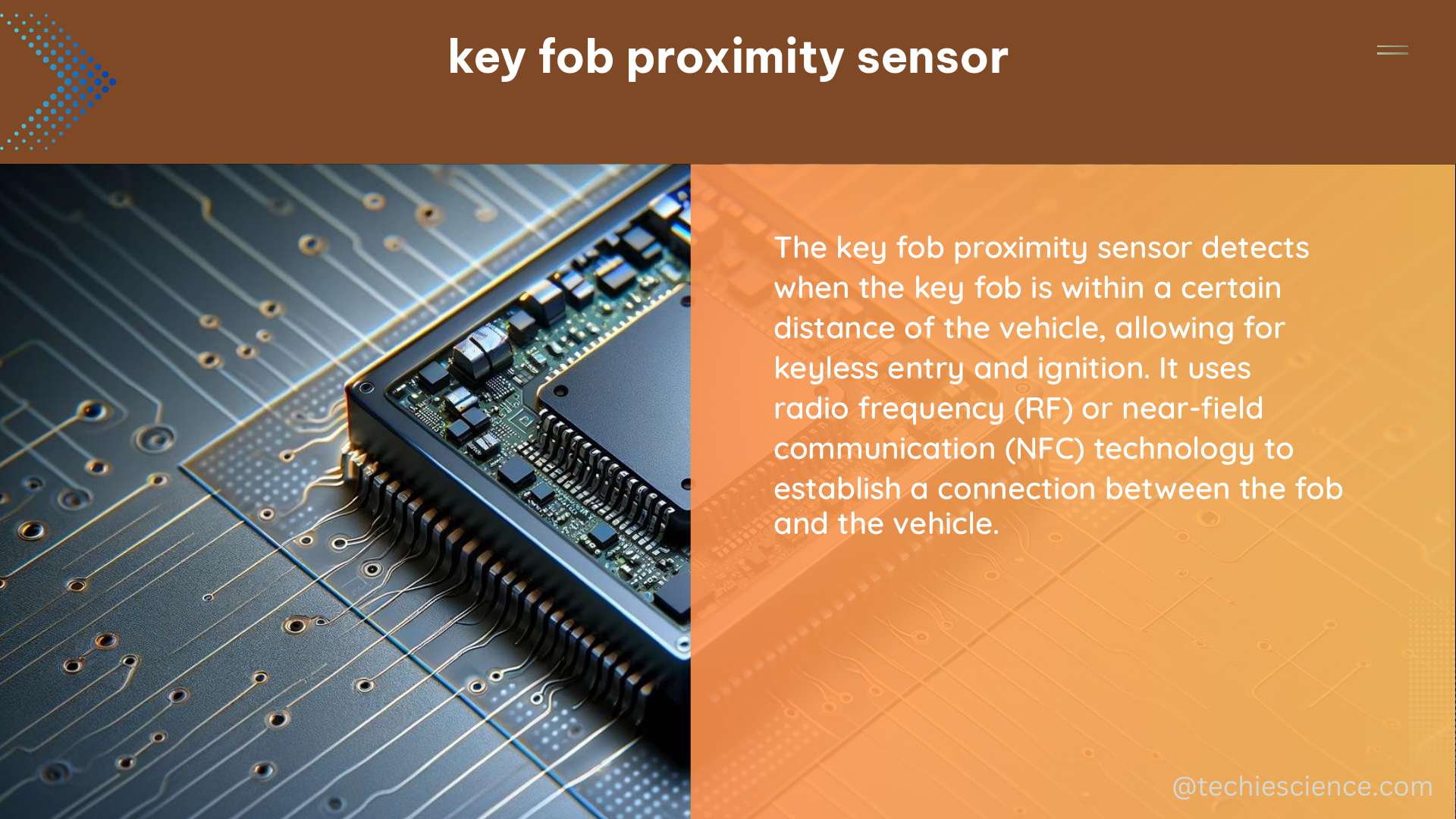The key fob proximity sensor is a versatile technology used in various applications, including automotive and home automation systems, to detect the presence of a key fob within a specific range. This technology plays a crucial role in enhancing convenience, security, and energy efficiency by enabling seamless automation and control based on the user’s proximity.
Understanding Key Fob Proximity Sensor Technology
Key fob proximity sensors utilize a range of wireless communication technologies, each with its own unique characteristics and applications. These include:
-
Wi-Fi-based Location Services: These sensors can detect the presence of a device, such as a smartphone or key fob, within a range of a few meters. The accuracy of Wi-Fi-based location services can be influenced by factors like signal interference, obstacles, and the number of access points in the area.
-
Bluetooth Low Energy (BLE) Beacons: BLE beacons provide more accurate detection within a range of 0.5 to 2 meters. They are commonly used in home automation and indoor positioning systems due to their low power consumption and ability to transmit location-based information.
-
NFC (Near-Field Communication) or RFID (Radio Frequency Identification) Readers: These sensors require the tag or phone to be in very close proximity, usually less than 0.1 meters, to the reader for successful detection. NFC and RFID technologies are often used in access control systems, mobile payments, and asset tracking applications.
Key Fob Proximity Sensor Applications

Home Automation
In the context of home automation, key fob proximity sensors can be used to trigger specific actions, such as unlocking a gate, turning on lights, or adjusting the thermostat, as the user approaches or leaves a particular area. This can be achieved using various hardware and software platforms, such as ESPHome, which allows users to install components like NFC/RFID readers, BLE beacons, or BLE devices onto ESP32 boards. These components can then be used to read the RSSI (Received Signal Strength Indication) of nearby devices, enabling the creation of automation rules based on the user’s proximity.
Automotive Applications
Key fob proximity sensors are widely used in automotive applications, particularly in keyless entry and ignition systems. These sensors detect the presence of the key fob within a specific range, allowing the user to unlock the car doors, start the engine, or access various vehicle functions without physically interacting with the key fob.
Industrial and Commercial Applications
Key fob proximity sensors find applications in industrial and commercial settings, such as access control systems, asset tracking, and industrial automation. These sensors can be used to monitor the movement of personnel, equipment, or inventory, triggering specific actions based on the proximity of the key fob or RFID tag.
Designing a Key Fob Proximity Sensor System
When designing a key fob proximity sensor system, several factors need to be considered to ensure optimal performance and reliability:
-
Sensor Range: The sensor’s range should be sufficient to cover the desired area without causing false triggers or missing the user’s presence. Factors like the sensor technology, environmental conditions, and physical obstructions can affect the sensor’s range.
-
Sensor Accuracy: The accuracy of the sensor is crucial, especially in applications where precise detection is required, such as in home automation or industrial control systems. Factors like signal interference, multipath effects, and environmental conditions can impact the sensor’s accuracy.
-
Power Consumption: Power consumption is a critical factor, as it can significantly impact the battery life and overall system performance. The choice of sensor technology and the design of the power management system can greatly influence the power consumption of the proximity sensor system.
-
Compatibility: Compatibility with other devices and systems, such as smartphones, home automation platforms, or industrial control systems, is essential to ensure seamless integration and operation. Adherence to industry standards and protocols can facilitate interoperability and ease of integration.
-
Scalability and Expandability: The proximity sensor system should be designed with scalability and expandability in mind, allowing for the addition of more sensors or the integration of new technologies as the system requirements evolve.
-
Security and Privacy: In applications involving sensitive information or access control, the proximity sensor system should incorporate robust security measures to protect against unauthorized access and ensure user privacy.
-
Reliability and Maintenance: The proximity sensor system should be designed for reliable operation, with mechanisms in place for fault detection, self-diagnostics, and easy maintenance to ensure long-term performance and minimize downtime.
Conclusion
Key fob proximity sensors are versatile technologies that play a crucial role in various applications, from automotive to home automation and industrial control systems. By understanding the underlying technologies, their capabilities, and the design considerations, users can create reliable and efficient proximity-based automation systems that enhance convenience, security, and energy efficiency.
References
- Proximity Sensor Like Keyless Car Keys
- Proximity Sensing Technologies for Smart Home Applications
- Keyence Data Loggers and Proximity Sensors
- Keyfob Proximity Sensor Failure
- Proximity Sensing Technologies for Smart Home Applications

The lambdageeks.com Core SME Team is a group of experienced subject matter experts from diverse scientific and technical fields including Physics, Chemistry, Technology,Electronics & Electrical Engineering, Automotive, Mechanical Engineering. Our team collaborates to create high-quality, well-researched articles on a wide range of science and technology topics for the lambdageeks.com website.
All Our Senior SME are having more than 7 Years of experience in the respective fields . They are either Working Industry Professionals or assocaited With different Universities. Refer Our Authors Page to get to know About our Core SMEs.